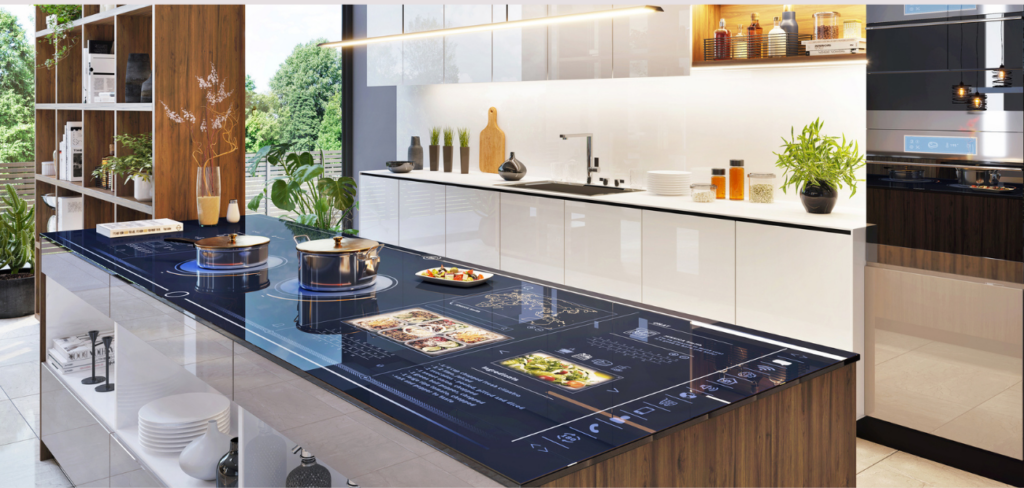Luxury home buyers expect the convenience and peace of mind of a professionally installed smart home system, but they don’t want to know it’s there. Nothing is worse than a big bank of switches on the wall and trying to get them all set correctly. With systems like Lutron, Crestron or Josh.ai, homeowners can set the scene and control their smart devices with a single button.
Likewise, using a smart home professional, such as a certified CEDIA integrator, helps homeowners ensure technology upgrades don’t impede the design of their home. This includes in-wall panels, hidden speakers, designer faceplates and the popular Samsung Frame TV, which displays art when you’re not watching TV.
Get Your Wires Straight
With smart technology, there’s a big misconception that everything has gone wireless. However, most routers cannot handle the number of devices found in a larger home, and it would be difficult to get Wi-Fi to reach from one end of the home to the other without using access points. By strategically planning where to put low-voltage wires, however, those in larger homes can install additional equipment in the future without opening the walls, which is much more expensive. This all starts with a robust pre-wire at the time of the build, when possible. So, if you’re building your home, that’s the time to think about adding wires to outfit a home with tech. It’s possible you’re not building your home from the ground up. Another time you can add wires is during a major renovation.
Plan for Placement
Think about where you may want to place TVs, computers, security cameras and speakers. You may even decide to put an outlet in the middle of the floor for a desk, lamp or couch. Running multiple category wires or tech tubes to key media locations is a terrific way to future-proof the home. You’ll want to know where your internet comes into the home—called the demarcation—and where you’ll house all the networking equipment, which is ideally away from any water sources and in a space with some cooling.
Situate the Control Station
Systems like Crestron and Josh.ai tie all the home controls together and act as the brains of the property. You’ll often find a rack in the utility room or dedicated space where all the ethernet cables, speaker wire and control cables come together. In this space, all the systems can communicate with each other, starting with the network itself. A control station of sorts, you’ll also likely find a power conditioner, central controller, any media inputs, and equipment for audio and video distribution.
Centralizing the systems creates more flexibility throughout the home. For instance, you can listen to music throughout the home but choose different volume levels for different areas. You can also play different songs in different rooms. Watch the big game or your favorite show no matter what room you’re in, without turning on multiple receivers and selecting a channel or app. Instead of requiring a cable box, some kind of plug-in option for television service, like Apple TV, Roku or a FireStick, and an audio video receiver at each TV location, creating a control station means everything is done from one hub.
Both Crestron and Josh.ai offer universal remote controls that make switching between cable, Netflix, and your favorite gaming system a breeze. One remote can control all devices, including the TV/Projector, speakers, sources, lighting and even climate.
Make The DIY Method Work
DIYers can certainly build out similar experiences with several ecosystems, but many rely on the cloud, contain ads, and have subscriptions associated with them. If one company changes how it integrates with another, service disruptions can occur, and different companies may require multiple apps.
One way to elevate that issue is by using a CEDIA integrator as they ensure a seamless, safe and professionally installed smart home experience without all the drawbacks of DIY solutions.
“CEDIA integrators offer customized systems that minimize the risks of disruptions caused by DIY or third-party integrations,” says Daryl Friedman, CEDIA’s Global President and CEO. “They provide a unified control system, eliminating the need for multiple apps, and offer expert support for a reliable, cohesive, and high-quality smart home setup.
For those with privacy concerns, Josh.ai offers advanced voice assistance along with its traditional control interfaces that seamlessly integrate with Crestron, Control4, Sonos, Lutron and many other popular smart home brands. They offer an elegant solution designed with style in mind, understand contextual voice command, and intuitively interprets conversational requests. Luxury homeowners also enjoy a minimalist, combined smart home experience through Josh.ai’s app, touch screen and universal remotes that provide access to the myriad smart features they have installed. This includes lighting, shades, HVAC, music, video and more.
While touring the Artisan homes this spring, I was pleased to see that the local builders and homeowners have fully embraced smart home technology. Most homes I saw had some form of lighting control, robust networks and the ever so popular Samsung Frame TV, all of which was accomplished by working with an integrator early in the process and planning ahead based on the homeowners’ needs.

